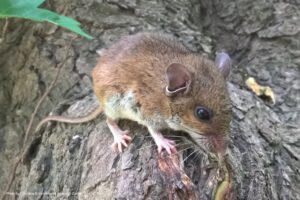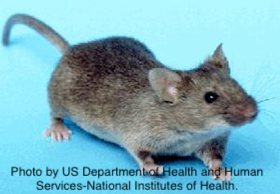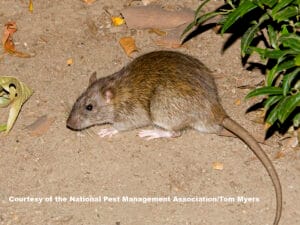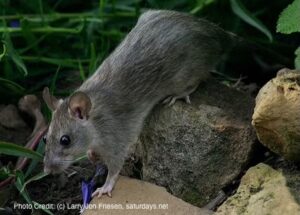Rodent Control & Extermination
Rats and mice can find their way into your home through extremely small holes. Once there, they may cause damage in their search for food or water, or when they build their nests. They have also been known to chew through wires and cause home alarm systems to go off! Mice and rats may also carry diseases that can affect humans (Hantavirus) or bring in disease-carrying fleas, ticks or lice. In some cases, you may not see the mice or rats, but may find droppings that indicate a problem. While you may be able to capture and remove the rodents, if you do not identify and seal every possible entry into your home, they are sure to return. If you have a problem with mice or rats, it’s time to call your local pest control heroes at Clegg’s! We have over 50 years of experience helping home and business owners with rats and mice and we can help you too. Call us or schedule your FREE initial inspection through the form below!
How do I know if I have mice in my house?
The most obvious way to know you have a mouse problem is of course to see a mouse in your house, but there are definitely other ways to tell if a mouse has set up residence in your home. These signs of mice or rats include, but are not limited to, the following:
Odd pet behavior: If your pet continually sniffs, watches, or scratches at a specific area of the house such as a crack between the stove and refrigerator, a specific wall, a space between moldings, etc, this could indicate rodent activity.
Bite Marks: If you notice small bite marks or scratch marks on food containers, wrappings, food items themselves, etc. you probably have a rodent problem. For example; if you had brownies covered in tin foil on your stove and in the morning there were little marks and slightly shredded tin foil around the brownies, you made a mouse very happy and it’s currently hiding somewhere enjoying its sugar high. Go ahead and toss those brownies out and call our team at Clegg’s!
“Grease trails”: These trails usually mean an infestation, and are usually a dirty looking mark along popular paths that the mice take when exploring/scavenging. These trails are left from the greasy residue from their bodies as well as from urine. These can appear anywhere, but typically will be under counter ledges, narrow places, against walls, etc. Mice tend to be more timid and travel against walls and areas where they feel less exposed.
Droppings or small hairs: Mice droppings look like small black pellets and can often be found around their food or water source. They can also be found in open food if the rodent has found a way in, such as an open cereal box, etc. It’s important to ensure any mice droppings are properly cleaned up and handled, as they can carry diseases harmful to humans. It’s also important to ensure there are no readily available food/water sources for rodents to get into, including pet food, as these attract rodents and make it very hard to break the feeding/breeding cycle. If you spot mouse droppings, call in the pros at Clegg’s.
Nests/nesting materials: A typical house mouse nest will look like a small 4-6 inch ball of shredded material. Materials can be insulation, paper, pillow batting, string, fabric, etc. If you see any of these things shredded in your house, go ahead and give us a call.
Scratching or scuttling noises: Often if you have a larger infestation, you will hear it before you see it. Rats are notorious for hanging out in attics, and can be heard most at night when they come out to scavenge for food. Mice on the other hand can often fit into small holes or spaces where baseboards don’t meet, moldings don’t come down entirely flush with the floor, or any small hole the size of a pencil eraser, leading them to establish residency inside of walls
If you have noticed any of these signs of rodent activity in your home, contact your local Clegg’s pest control heroes and let us get to work getting those critters out of your home!
Common Rats and Mice in North Carolina
Deer Mice

The deer mouse rarely invades homes and is found in rural areas.
Color: Brown, with white feet and underbelly
Size: 5 to 8 inches long
Habits: The deer mouse prefers the outdoors.
Habitat: The deer mouse makes its home outdoors in sheltered areas such as hollow tree logs or piles of debris. On the rare occasions the deer mouse comes indoors, it prefers undisturbed areas such as attics.
Threats: The deer mouse transmits the potentially fatal Hantavirus Pulmonary Syndrome. The disease can be transmitted through contact with mouse carcasses, or by breathing in aerosolized urine droplets of infected deer mice.
Prevention: To keep mice and other rodents out, make sure all holes of larger diameter than a pencil are sealed. Mice can squeeze through spaces as small as a nickel. Seal any cracks and voids. Don’t overlook proper drainage at the foundation and always install gutters or diverts which will channel water away from the building. Use heavy gloves and protective breathing gear when working in an area populated by deer mice.
House Mice

The house mouse is the most common rodent pest in most parts of the world. It can breed rapidly and adapt quickly to changing conditions.
Color: Light brown to black
Size: 2″
Habits: House mice can breed throughout the year and can share nests.
Habitat: House mice live in structures, but they can live outdoors.
Threats: Micro droplets of mouse urine can cause allergies in children. Mice can also bring fleas, mites, ticks and lice into your home.
Prevention: To keep mice and other rodents out, make sure all holes of larger diameter than a pencil are sealed. Mice can squeeze through spaces as small as a nickel. Seal any cracks and voids. Don’t overlook proper drainage at the foundation and always install gutters or diverts which will channel water away from the building.
Norway Rat

These rats have smaller eyes and ears and shorter tails.
Color: Gray, brown or black
Size: 10 to 12 inches (8″ body plus 4″ tail)
Habits: Rats are excellent climbers and often enter a home in the fall when outside food sources become scarce.
Habitat: Norway rats live in fields, farm lands and in structures. Rats are often found in woodpiles. Rodents can gain entry to a home through a hole the size of a quarter.
Threats: Rats can chew through wiring, causing fires. They also spread numerous diseases.
Prevention: Keep firewood stored well away from the structure. Remove debris piles. Seal any holes larger than 1/4 inch. Remove moisture and harborage sources.
Roof Rats

Roof rats get their name from their tendency to be found in the upper parts of buildings. Ranging in size from 6 to 8 inches in length, not including their tails, they have very poor vision and are color blind. They do have extremely strong senses of hearing, smell, touch and taste.
Color: Black
Size: 16″ total (6-8″ body plus 6-8″ tail)
Habits: Roof rats are known for the damage they cause by chewing on materials and eating stored foods.
Habitat: Roof rats can be found in the upper parts of buildings, and can also be found under, in and around structures. They only need a space of one-half inch to get into buildings.
Threats: Roof rats secured their place in history by spreading the highly dangerous bubonic plague. They support many ectoparasites and urinate on food.
Prevention: To prevent rats from entering a home, seal up any holes or cracks larger than a quarter. Remove sources of moisture and harborage.
“How Did The Mice Get In?”
There are a variety of entry possibilities:
- Construction near or around your home usually brings rodents.
- Unsealed holes in and around your home (underneath sinks, dryer vents, cracks in foundation, etc.) allow rodents to access your home. Steel wool is a wonderful tool to seal these openings.
There are several options available to eliminate mice and rats. A service technician will recommend the best option after determining your specific situation.
Rodent Control Throughout North Carolina
Did you know our pest control heroes service throughout all of North Carolina? Here are some of the main markets we are proud to serve:
- Rodent control in Asheville
- Rodent control in Charlotte
- Rodent control in Clinton
- Rodent control in Durham
- Rodent control in Fayetteville
- Rodent control in Greenville
- Rodent control in Kernersville
- Rodent control in Morehead City
- Rodent control in New Bern
- Rodent control in Raleigh
- Rodent control in Smithfield
- Rodent control in Southport
- Rodent control in Wilmington
If you think you have a problem with mice or rats, it’s time to call your local pest control heroes! Call us or request your FREE initial inspection online to eliminate the rats and mice before they reproduce or cause additional damage.
